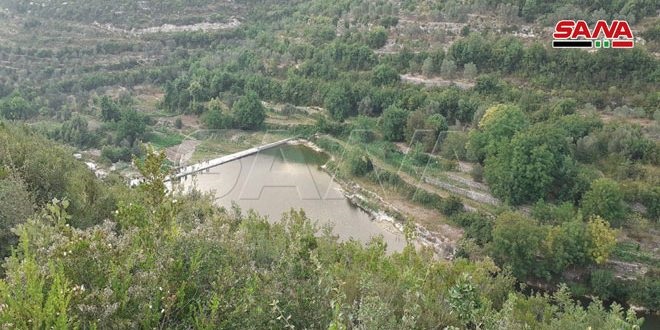The village of “ Al-Samaiheqa” in Tartous countryside is a very old village dating back to the Aramaic era and characterized by its distinguished location between the mountains and valleys in addition to its charming nature. This has turned it into a unique destination which attracts lovers of camping and ecotourism as well as teams and associations concerned with nature.
The village, which is located to the west of the city of Al-Qadmous in the countryside of Tartous, includes medium and dense forests and a winter watercourse containing abundant waterfalls of great beauty.
There are many opinions and narratives about the reason for its name. Fawaz Ghannam, one of the village’s residents, told SANA that “AL-Samaiheqa” is the land with clay soil, which is in the form of a thin layer over the rocks. Another one said that the origin of the word is Phoenician and means God’s sacred sky.
According to Ghannam, the remarkable turnout which the village witnessed by nature lovers has contributed to the spread of tourism investments in it in addition to the “Zip Line” project, “Skiing on a rope between two mountains”, which is the first of its kind in Syria. This project made Syria famous and has become today an important and famous destination for tourists from different parts of the country and abroad.
Ghannam pointed out that there are special sites for camping and various paths for lovers of hiking and walking in the village.
It rises 680 meters above sea level, but the height of its lands ranges between 450 and 750 meters, which makes the village of rugged nature containing steep valleys as well as high mountains and cliffs.
 Ghannam underlined that its rugged nature, in addition to the woods, green forests and the stream of waterfalls, has given “Al-Samaiheqa” village a special beauty, indicating to the spread of forest trees including oaks , laurel , basil, and plums next to waterways.
Ghannam underlined that its rugged nature, in addition to the woods, green forests and the stream of waterfalls, has given “Al-Samaiheqa” village a special beauty, indicating to the spread of forest trees including oaks , laurel , basil, and plums next to waterways.
“Al-Samaiheqa” includes some ancient monuments that date back to multiple historical periods in addition to the archaeological spring in the region. The residents of the village depend on the cultivation of tobacco, olives, walnuts, vine, and raising livestock and poultry..
Rawaa Ghanam

